
Trinity
Explainable AI analysis tool and 3D visualization
Stars: 93
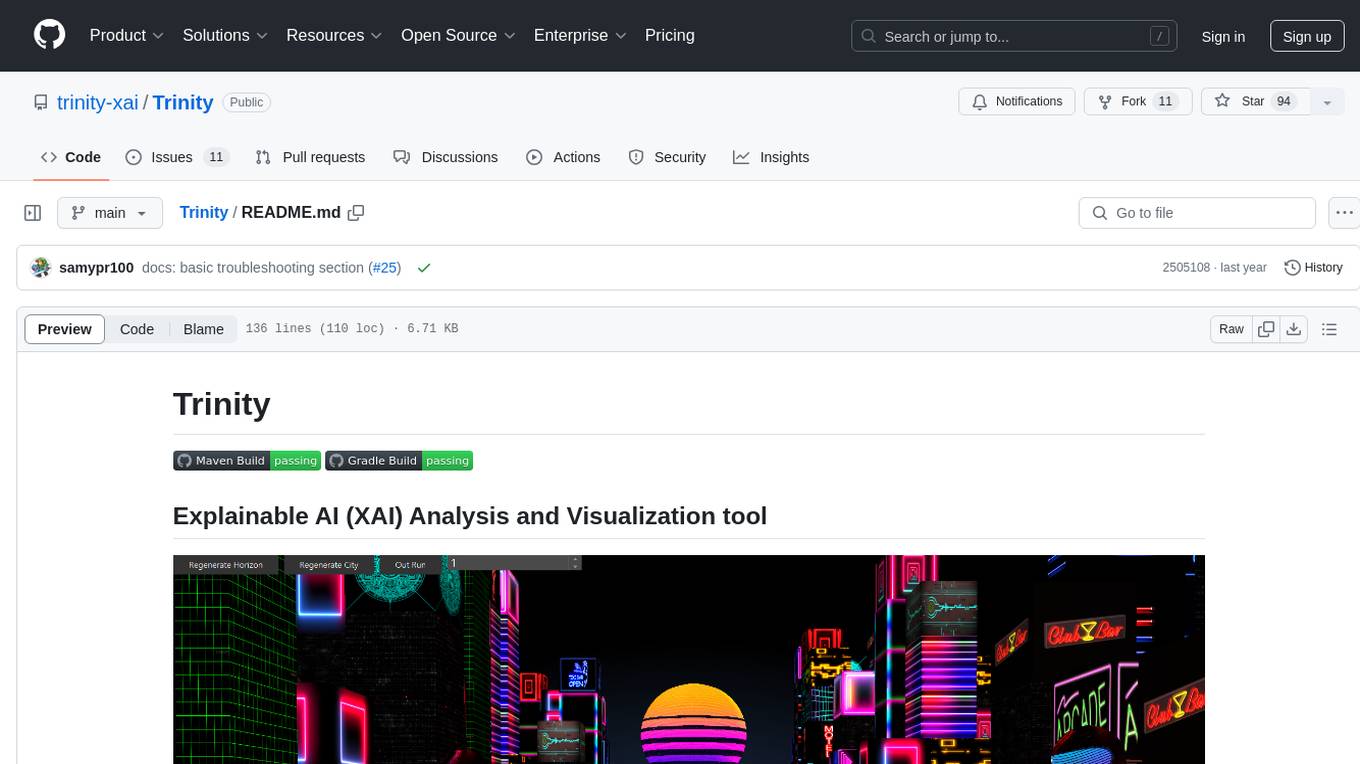
Trinity is an Explainable AI (XAI) Analysis and Visualization tool designed for Deep Learning systems or other models performing complex classification or decoding. It provides performance analysis through interactive 3D projections that are hyper-dimensional aware, allowing users to explore hyperspace, hypersurface, projections, and manifolds. Trinity primarily works with JSON data formats and supports the visualization of FeatureVector objects. Users can analyze and visualize data points, correlate inputs with classification results, and create custom color maps for better data interpretation. Trinity has been successfully applied to various use cases including Deep Learning Object detection models, COVID gene/tissue classification, Brain Computer Interface decoders, and Large Language Model (ChatGPT) Embeddings Analysis.
README:
Trinity provides performance analysis and XAI tools ideal for Deep Learning systems or other models performing complex classification or decoding. Trinity does this through a combination of different interactive 3D projections that are hyper-dimensional aware. (Vectors of Vectors)
 Trinity's Hyperspace view provides a 3D scatter plot with automatic 2D projections of feature/factor data.
The dimensional combinations can be instantly switched to rapidly search through hyper-dimensional space.
The user can pan, rotate and zoom either the 3D camera or the points themselves.
The scatter points are interactive allowing the user to select individual points to bring up the associated data/imagery with that feature.
Trinity's Hyperspace view provides a 3D scatter plot with automatic 2D projections of feature/factor data.
The dimensional combinations can be instantly switched to rapidly search through hyper-dimensional space.
The user can pan, rotate and zoom either the 3D camera or the points themselves.
The scatter points are interactive allowing the user to select individual points to bring up the associated data/imagery with that feature.
 Trinity can visualize higher dimensional inputs (before decoding) as a 3D surface.
Hypersurface view provides analyst insight into what inputs correlate strongest with a decoding/classification result.
This view is synchronized with the same FeatureVectors and Timeline as the Hyperspace viewpoint.
Trinity can visualize higher dimensional inputs (before decoding) as a 3D surface.
Hypersurface view provides analyst insight into what inputs correlate strongest with a decoding/classification result.
This view is synchronized with the same FeatureVectors and Timeline as the Hyperspace viewpoint.
 Trinity provides a fast parallelized UMAP tool with a simple to use GUI to project the hyper-dimensional embeddings
down to an arbitrary lower dimensional space. This allows analysts to project approximate manifolds as 3D clusters.
Trinity provides a fast parallelized UMAP tool with a simple to use GUI to project the hyper-dimensional embeddings
down to an arbitrary lower dimensional space. This allows analysts to project approximate manifolds as 3D clusters.
Trinity primarily speaks JSON and has a collection of serializable JSON message objects that can be imported. The primary message that most applications will leverage is the FeatureVector. Example:
{
"messageType": "feature_vector",
"messageId": 0, #optional long value for order or id of data point
"data": [-0.4232191175986961, -0.5031443592838056, 0.30497221256679125,
0.4157550505277444, -0.46174460409303325, -0.12950797668733202,
0.6323170694189965, 0.20112482321095512, -0.0770502704073328,
#... some arbitrarily long vector of embeddings...#
-0.021781132983331605, 0.2855062868586593, -0.11389146262348109,
-0.4338320677142379, 0.14545007041168245, 0.34325194689681915
],
"score": -2.753245759396493, #Typically the classification score provide by model but could be any floating point value you choose
"pfa": 0.0008605957637858228, #Auxiliary floating point between 0 and 1 typically associated with a probability
"label": "some_object", #human readable string that is categorical
"bbox": [0.0, 0, 16.0, 0], #optional Coordinate set typically used for Bounding box identification but could be used for anything
"imageURL": "/media/images/video_frame_9001.jpg", #image associated with this data point. Supports *.png or *.jpg files. Also supports http based urls
"layer": 3, #Typically the layer of the model the embeddings were taken from but can represent any Integer based hierarchal info
"metaData" : { # Totally optional info hash map
"some name" : "some value",
"optional" : "string name/value pairs that provide additional info"
}
}FeatureVector objects can be sent to Trinity as a stream using ZeroMQ. The ZeroMQ connection is configured from the Data UI panel. Large collections of FeatureVector objects can be loaded at once as a file drag and drop using the FeatureCollection JSON object. The FeatureCollection object is simply an array of FeatureVector objects with a type field that Trinity uses to detect file type at Drag and Drop
{ "type": "FeatureCollection",
"features": [
...boat load of FeatureVector objects
]
}Trinity will auto colorize the data in both the Hyperspace and Projections views by the label field. It uses a rotational color map that has 12 predefined colors. Colors can be reassigned to color gradients using score, layer, pFa or even raw coordinate position via the GUI. The user can create custom color maps by label using the LabelConfig message. Labels can be explicitly colored by RGBA hex code. The LabelConfig also supports Java compatible regular expression wildcards. A LabelConfig json file can be simply dragged and dropped onto the Trinity application and it will automatically update the views.
{
"messageType": "label_config",
"wildcards" : {
"human_.*":"#0000FFFF",
"human_Original.*":"#FFFF00FF",
"chatGPT_.*":"#FF0000FF",
"chatGPT_Original.*":"#00FF00FF"
},
"clearAll" : "false"
}Trinity has been applied to a series of use cases including:
Deep Learning Object detection models

COVID gene/tissue classification

Brain Computer Interface decoders

Large Language Model (ChatGPT) Embeddings Analysis

- Sean M Phillips
- Melanie Lockhart
- Samuel Matos
- Gene Whipps
- Griffin Milsap
- David Newcomer
- Luis Puche Rondon
You can build with either Maven or Gradle with a modern version of Java (>=17).
There's already a set of scripts for building and running if you use a Jetbrains IDE or Netbeans to facilitate a cold start on the project.
To run the project from a jar after building, you can take a look at the scripts directory to get you started.
Otherwise, make sure to use at least -Dprism.maxvram=2G on your JVM parameters when starting it up.
For JLink/JPackage builds those JVM args are baked in already into the packages.
Execution permissions might need to be needed to run the JPackage, JLink, or Native builds
depending on which system you're running from. For example on OSX systems you might get
Unknown error: 111 or launch errors, hence you need to allow the app through GateKeeper via
xattr -r -d com.apple.quarantine /path/to/Trinity.app. You might also need to add execution
permissions in some cases via chmod +x /path/to/Trinity.app/Contents/MacOS/Trinity when using
the JPackage build.
For Tasks:
Click tags to check more tools for each tasksFor Jobs:
Alternative AI tools for Trinity
Similar Open Source Tools

Trinity
Trinity is an Explainable AI (XAI) Analysis and Visualization tool designed for Deep Learning systems or other models performing complex classification or decoding. It provides performance analysis through interactive 3D projections that are hyper-dimensional aware, allowing users to explore hyperspace, hypersurface, projections, and manifolds. Trinity primarily works with JSON data formats and supports the visualization of FeatureVector objects. Users can analyze and visualize data points, correlate inputs with classification results, and create custom color maps for better data interpretation. Trinity has been successfully applied to various use cases including Deep Learning Object detection models, COVID gene/tissue classification, Brain Computer Interface decoders, and Large Language Model (ChatGPT) Embeddings Analysis.
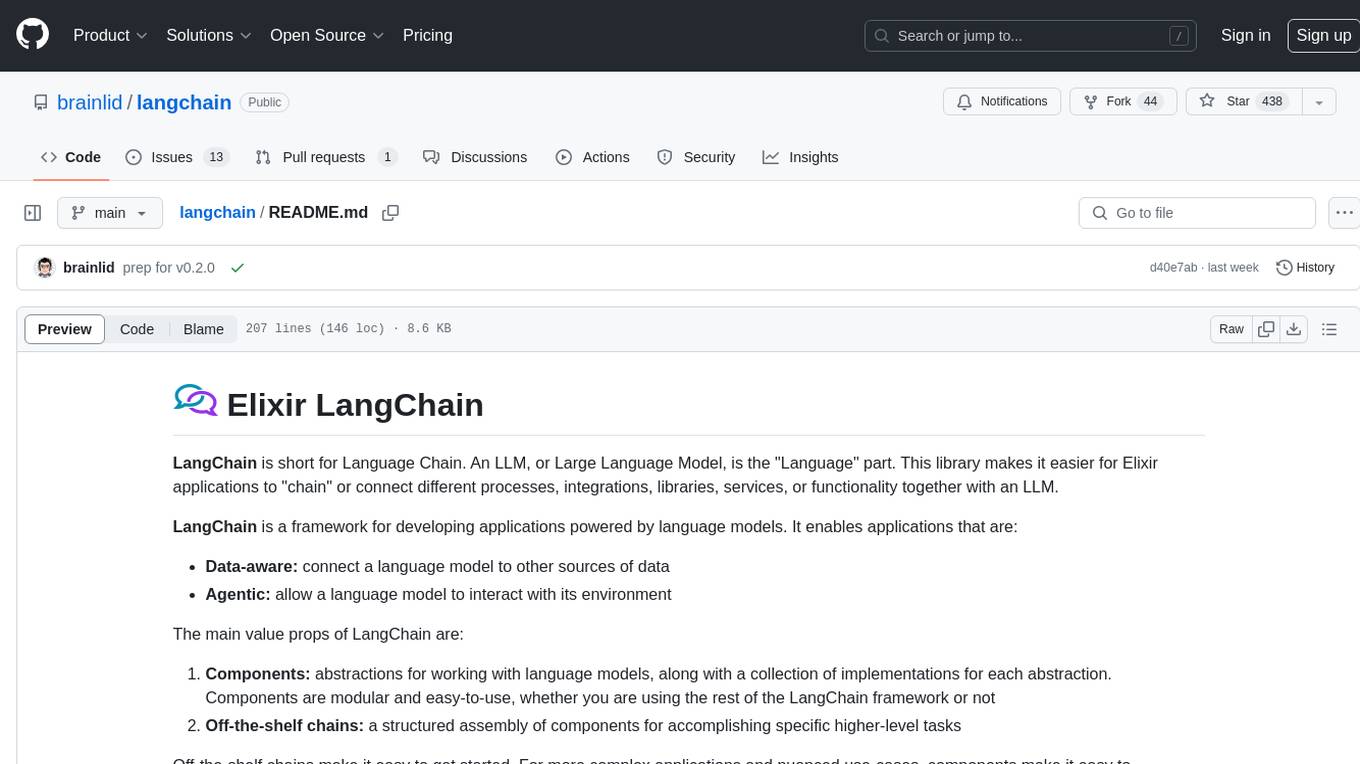
langchain
LangChain is a framework for developing Elixir applications powered by language models. It enables applications to connect language models to other data sources and interact with the environment. The library provides components for working with language models and off-the-shelf chains for specific tasks. It aims to assist in building applications that combine large language models with other sources of computation or knowledge. LangChain is written in Elixir and is not aimed for parity with the JavaScript and Python versions due to differences in programming paradigms and design choices. The library is designed to make it easy to integrate language models into applications and expose features, data, and functionality to the models.
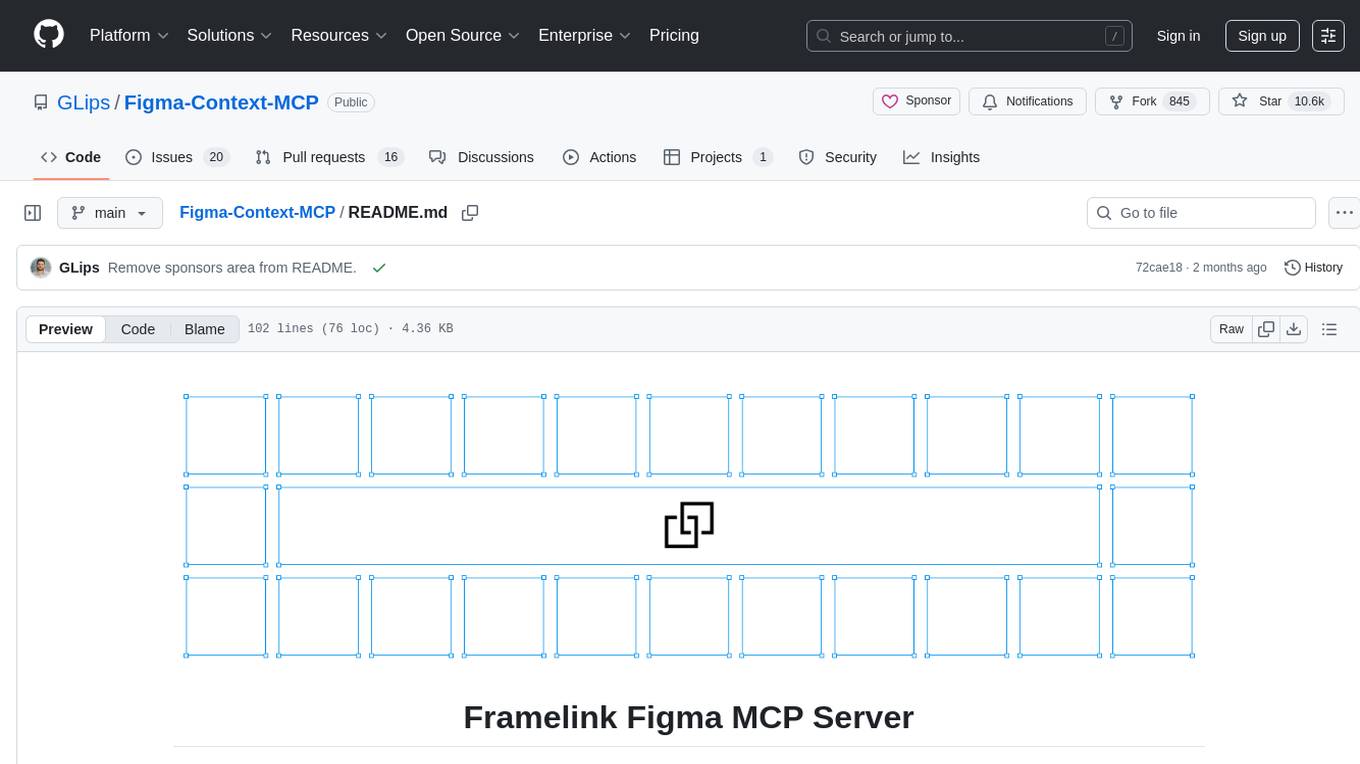
Figma-Context-MCP
Figma-Context-MCP is a plugin for Figma that allows users to easily manage and switch between multiple design contexts within a single Figma file. This tool simplifies the process of working on different design variations or versions by providing a seamless way to organize and switch between them. With Figma-Context-MCP, designers can streamline their workflow and improve collaboration by keeping all design contexts in one place and easily accessible. This plugin enhances productivity and efficiency for Figma users who frequently work on multiple design iterations or versions within a project.
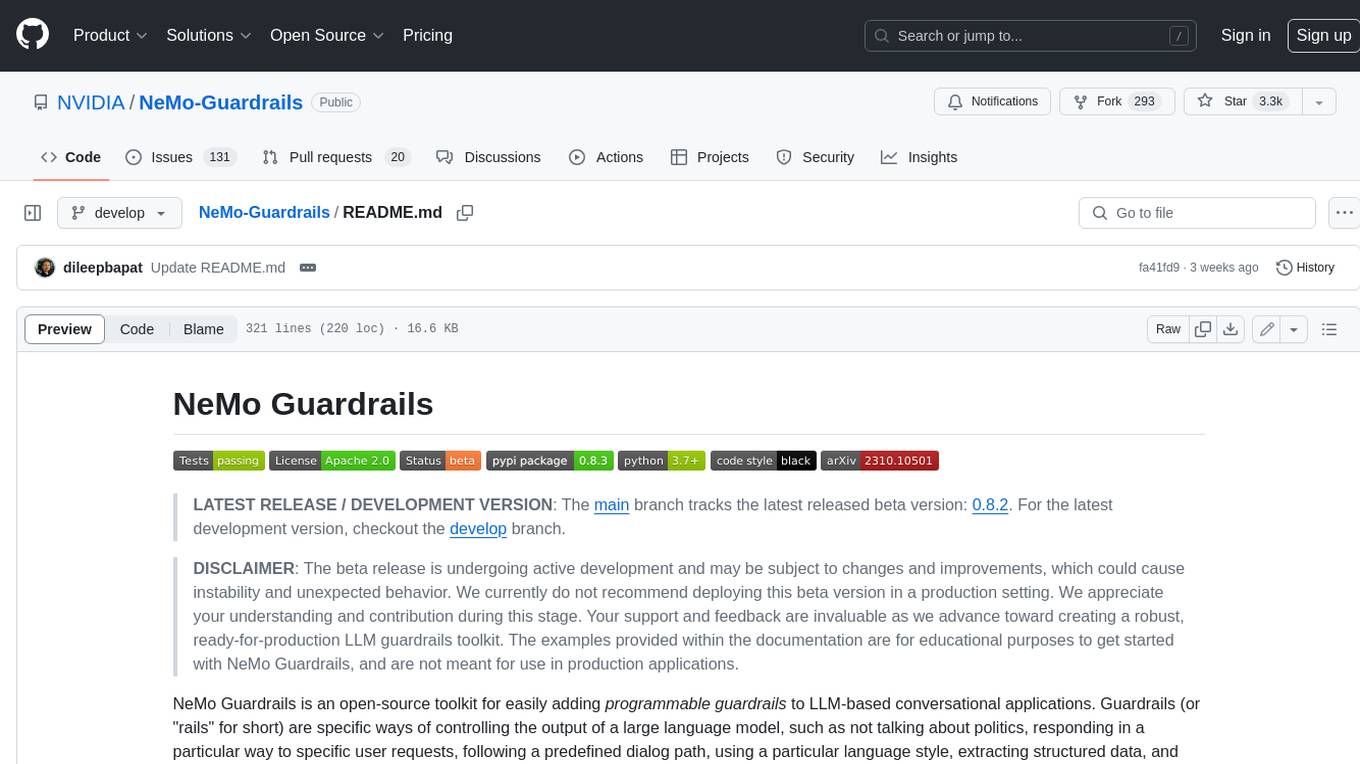
Guardrails
Guardrails is a security tool designed to help developers identify and fix security vulnerabilities in their code. It provides automated scanning and analysis of code repositories to detect potential security issues, such as sensitive data exposure, injection attacks, and insecure configurations. By integrating Guardrails into the development workflow, teams can proactively address security concerns and reduce the risk of security breaches. The tool offers detailed reports and actionable recommendations to guide developers in remediation efforts, ultimately improving the overall security posture of the codebase. Guardrails supports multiple programming languages and frameworks, making it versatile and adaptable to different development environments. With its user-friendly interface and seamless integration with popular version control systems, Guardrails empowers developers to prioritize security without compromising productivity.
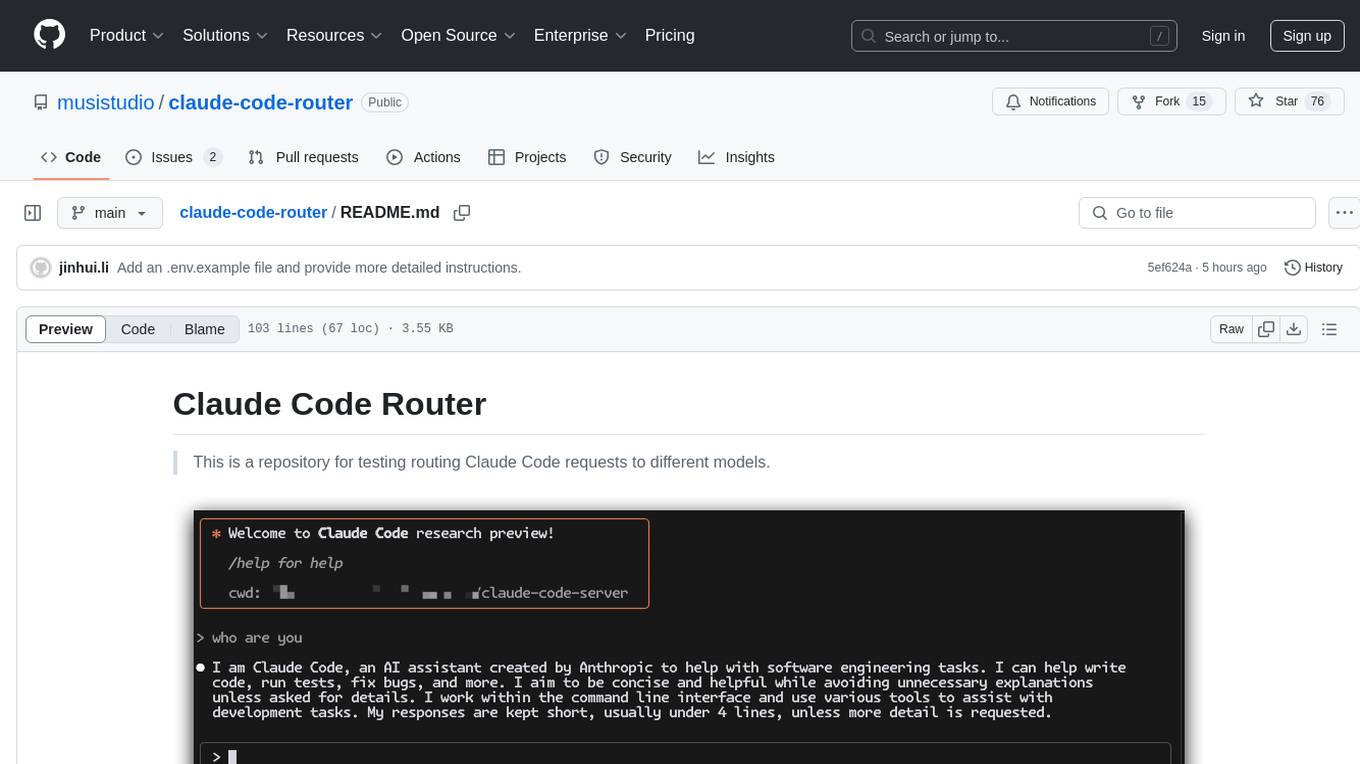
claude-code-router
This repository is for testing routing Claude Code requests to different models. It implements Normal Mode and Router Mode, using various models like qwen2.5-coder-3b-instruct, qwen-max-0125, deepseek-v3, and deepseek-r1. The project aims to reduce the cost of using Claude Code by leveraging free models and KV-Cache. Users can set appropriate ignorePatterns for the project. The Router Mode allows for the separation of tool invocation from coding tasks by using multiple models for different purposes.
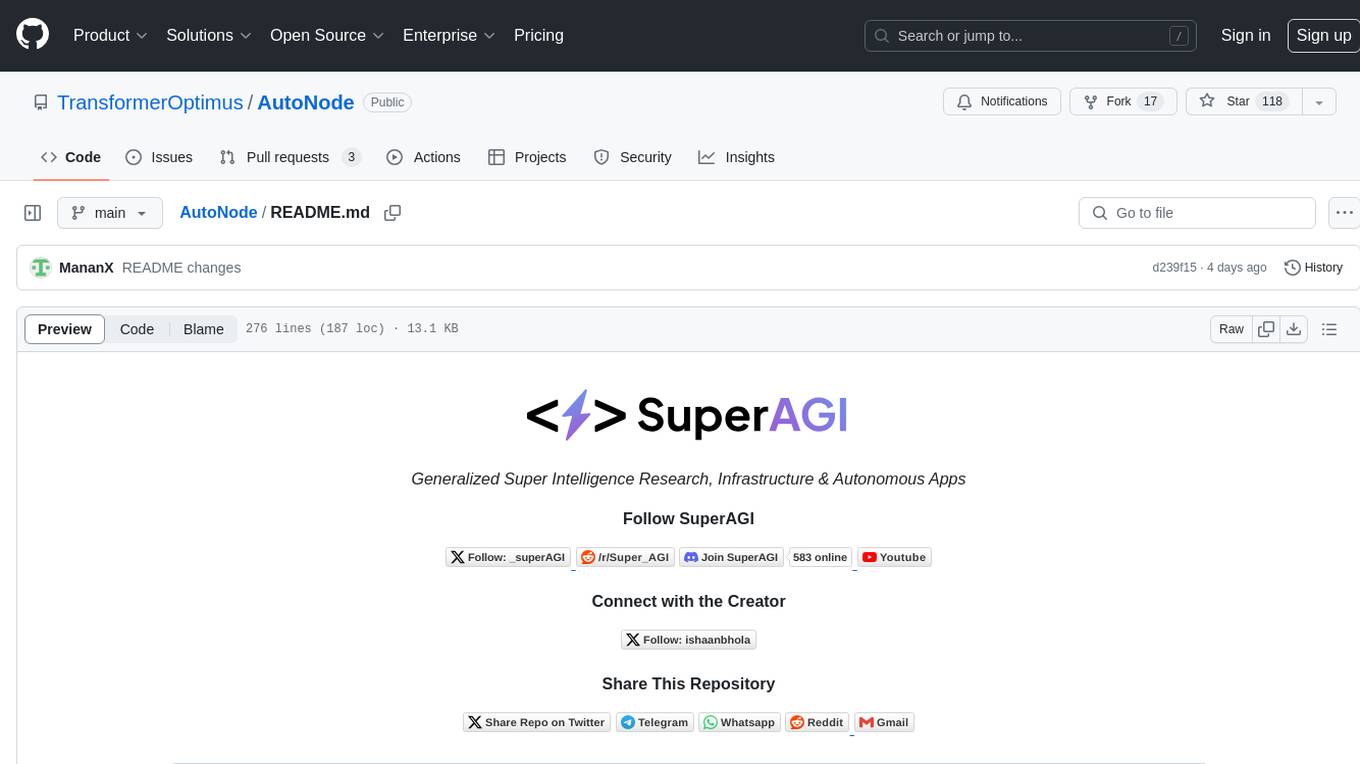
AutoNode
AutoNode is a self-operating computer system designed to automate web interactions and data extraction processes. It leverages advanced technologies like OCR (Optical Character Recognition), YOLO (You Only Look Once) models for object detection, and a custom site-graph to navigate and interact with web pages programmatically. Users can define objectives, create site-graphs, and utilize AutoNode via API to automate tasks on websites. The tool also supports training custom YOLO models for object detection and OCR for text recognition on web pages. AutoNode can be used for tasks such as extracting product details, automating web interactions, and more.
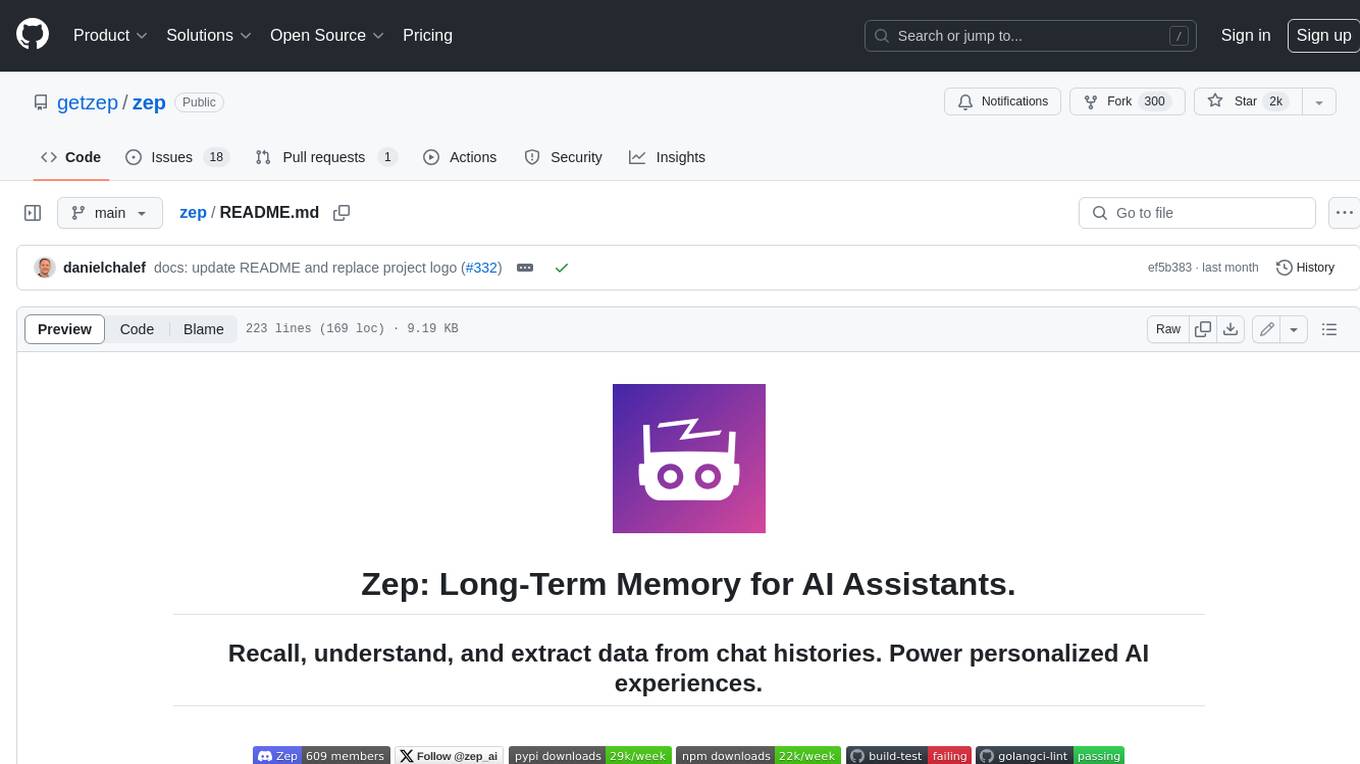
zep
Zep is a long-term memory service for AI Assistant apps. With Zep, you can provide AI assistants with the ability to recall past conversations, no matter how distant, while also reducing hallucinations, latency, and cost. Zep persists and recalls chat histories, and automatically generates summaries and other artifacts from these chat histories. It also embeds messages and summaries, enabling you to search Zep for relevant context from past conversations. Zep does all of this asyncronously, ensuring these operations don't impact your user's chat experience. Data is persisted to database, allowing you to scale out when growth demands. Zep also provides a simple, easy to use abstraction for document vector search called Document Collections. This is designed to complement Zep's core memory features, but is not designed to be a general purpose vector database. Zep allows you to be more intentional about constructing your prompt: 1. automatically adding a few recent messages, with the number customized for your app; 2. a summary of recent conversations prior to the messages above; 3. and/or contextually relevant summaries or messages surfaced from the entire chat session. 4. and/or relevant Business data from Zep Document Collections.
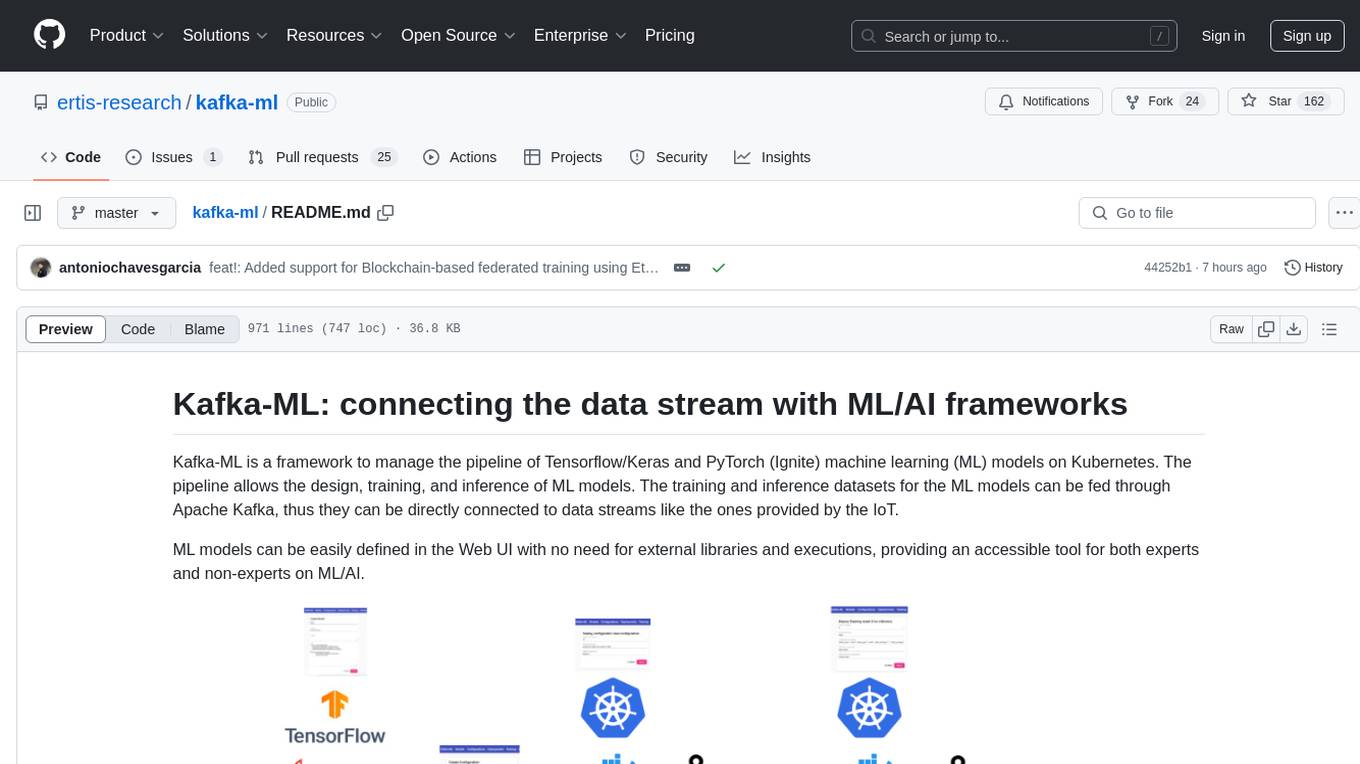
kafka-ml
Kafka-ML is a framework designed to manage the pipeline of Tensorflow/Keras and PyTorch machine learning models on Kubernetes. It enables the design, training, and inference of ML models with datasets fed through Apache Kafka, connecting them directly to data streams like those from IoT devices. The Web UI allows easy definition of ML models without external libraries, catering to both experts and non-experts in ML/AI.
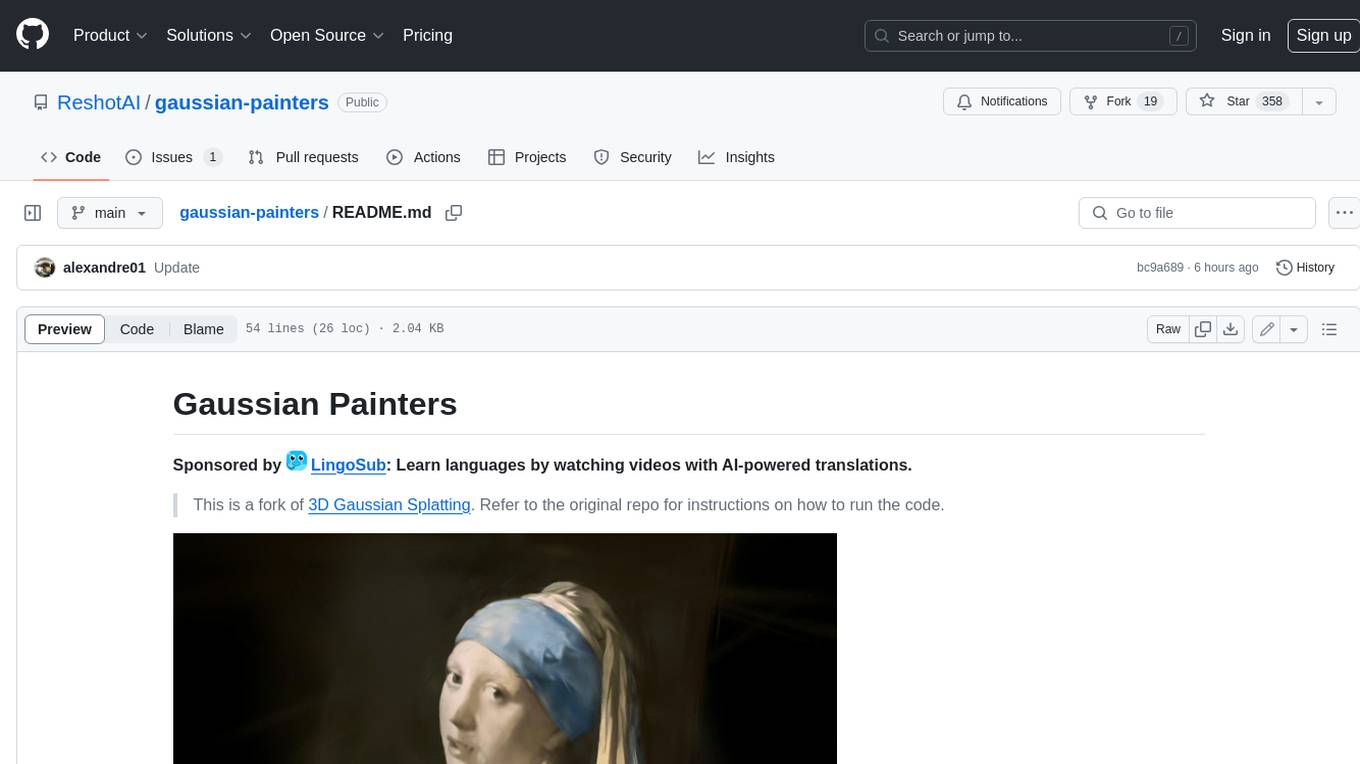
gaussian-painters
This tool is a fork of the 3D Gaussian Splatting code. It allows users to create a dataset ready to be trained with the Gaussian Splatting code. The dataset can be used for various experiments, such as creating orthogonal images, steganography, and lenticular effects. The tool also includes a visualizer that allows users to visualize the "painting" process during the Gaussian Splatting optimization.
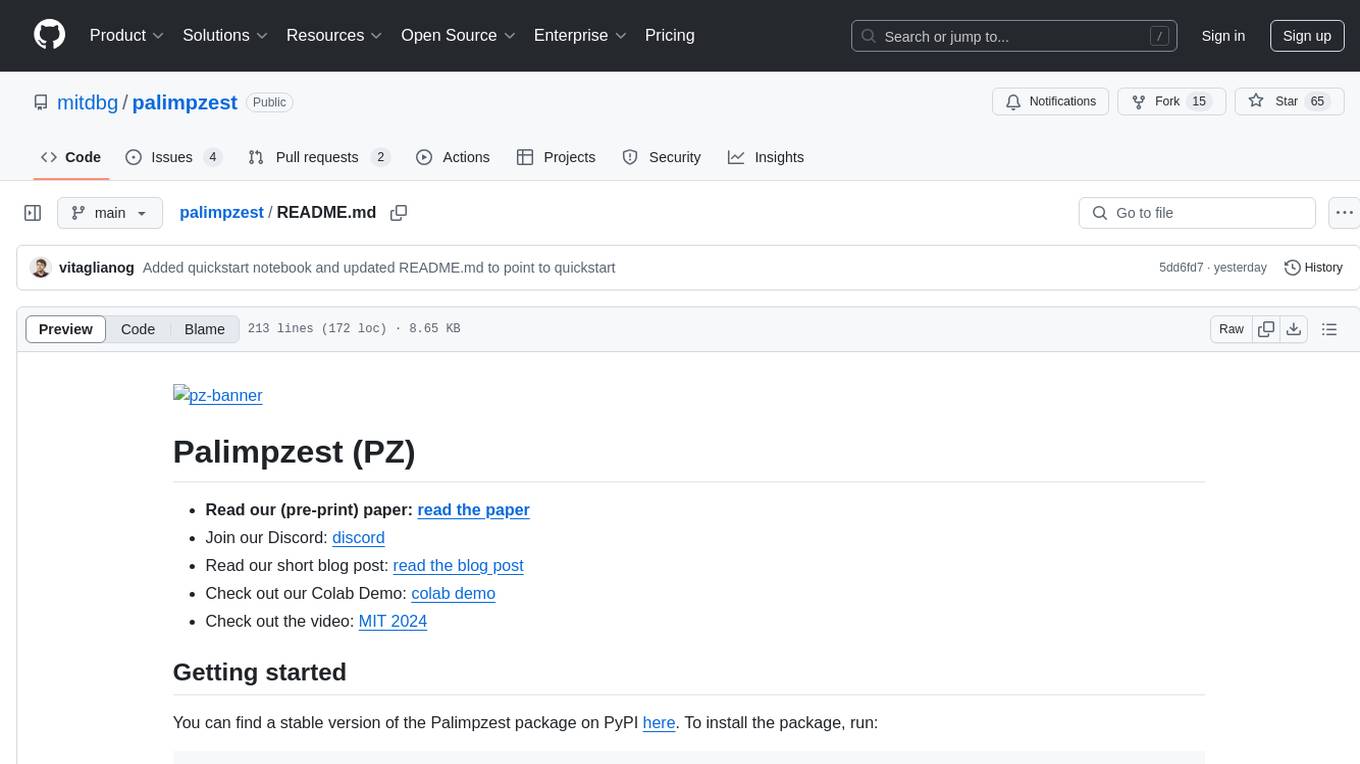
palimpzest
Palimpzest (PZ) is a tool for managing and optimizing workloads, particularly for data processing tasks. It provides a CLI tool and Python demos for users to register datasets, run workloads, and access results. Users can easily initialize their system, register datasets, and manage configurations using the CLI commands provided. Palimpzest also supports caching intermediate results and configuring for parallel execution with remote services like OpenAI and together.ai. The tool aims to streamline the workflow of working with datasets and optimizing performance for data extraction tasks.
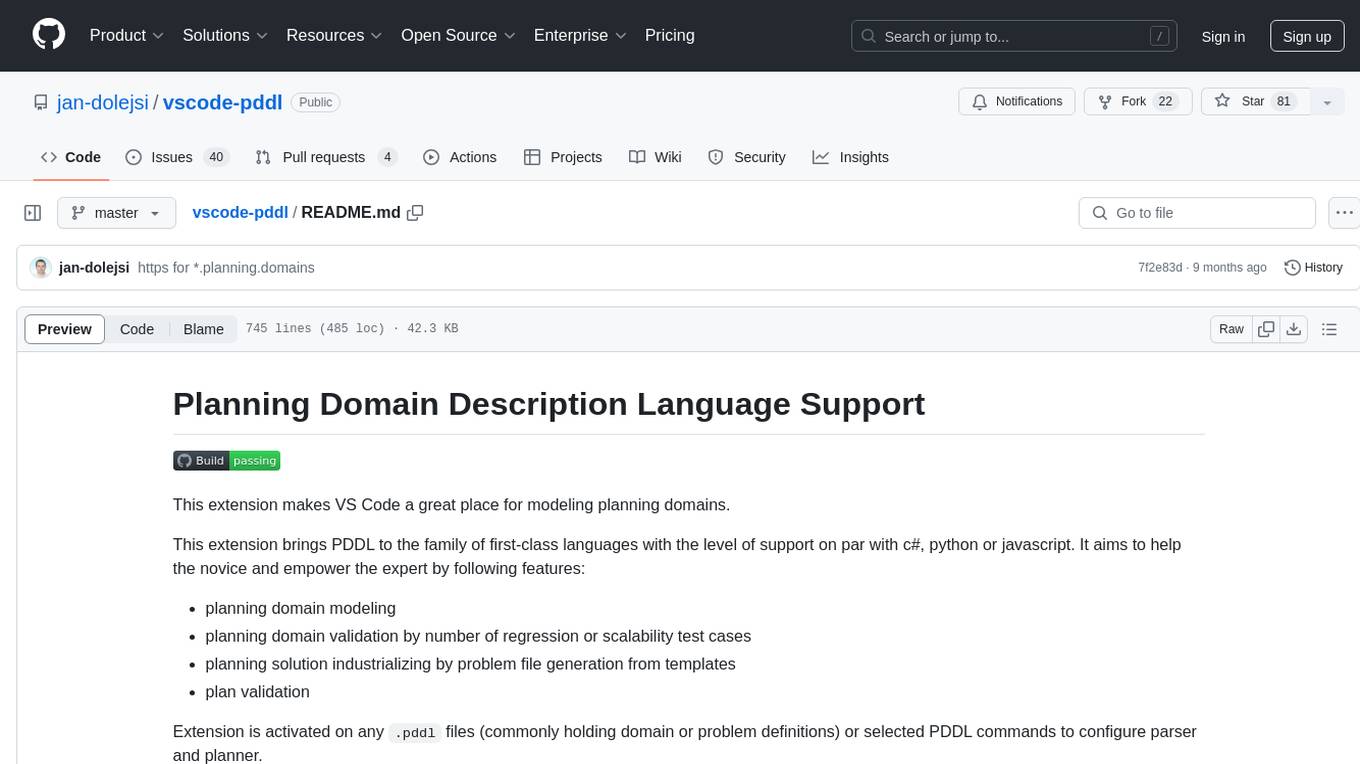
vscode-pddl
The vscode-pddl extension provides comprehensive support for Planning Domain Description Language (PDDL) in Visual Studio Code. It enables users to model planning domains, validate them, industrialize planning solutions, and run planners. The extension offers features like syntax highlighting, auto-completion, plan visualization, plan validation, plan happenings evaluation, search debugging, and integration with Planning.Domains. Users can create PDDL files, run planners, visualize plans, and debug search algorithms efficiently within VS Code.
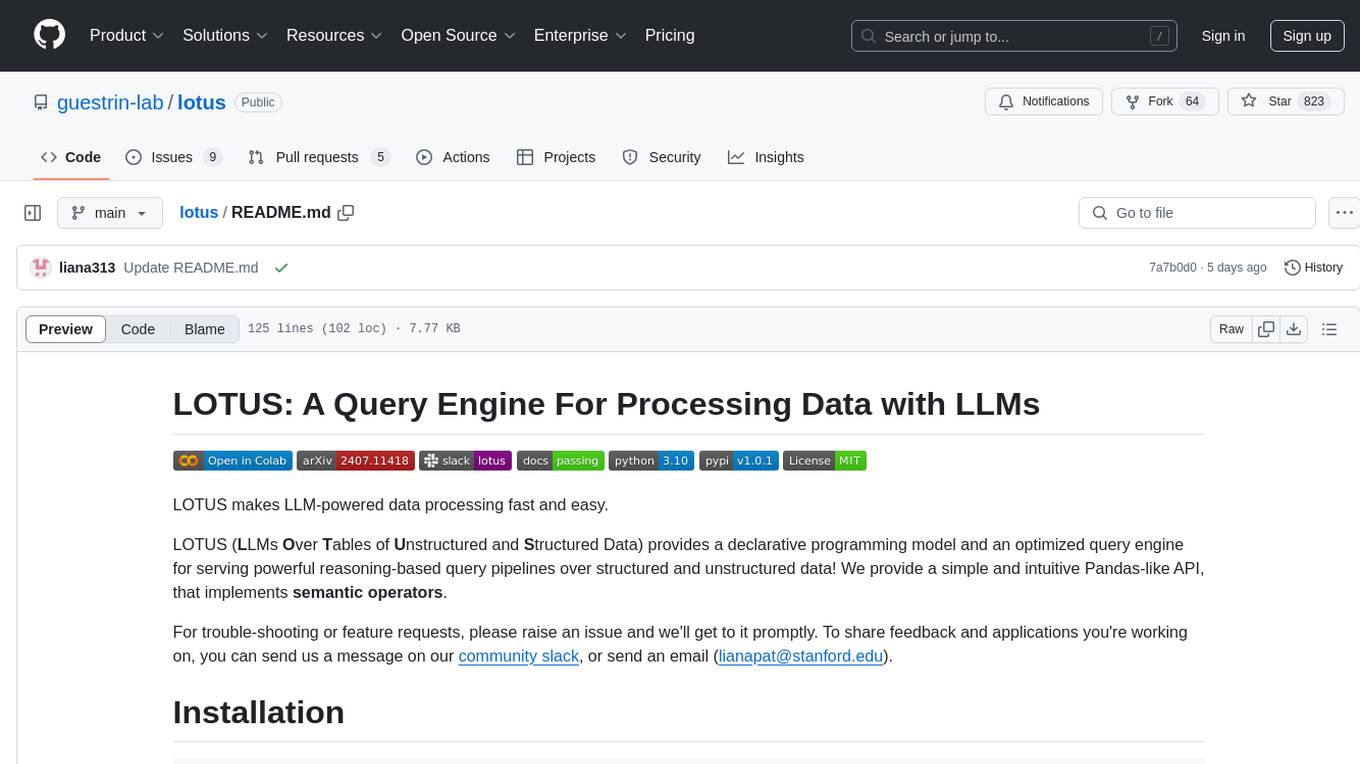
lotus
LOTUS (LLMs Over Tables of Unstructured and Structured Data) is a query engine that provides a declarative programming model and an optimized query engine for reasoning-based query pipelines over structured and unstructured data. It offers a simple and intuitive Pandas-like API with semantic operators for fast and easy LLM-powered data processing. The tool implements a semantic operator programming model, allowing users to write AI-based pipelines with high-level logic and leaving the rest of the work to the query engine. LOTUS supports various semantic operators like sem_map, sem_filter, sem_extract, sem_agg, sem_topk, sem_join, sem_sim_join, and sem_search, enabling users to perform tasks like mapping records, filtering data, aggregating records, and more. The tool also supports different model classes such as LM, RM, and Reranker for language modeling, retrieval, and reranking tasks respectively.
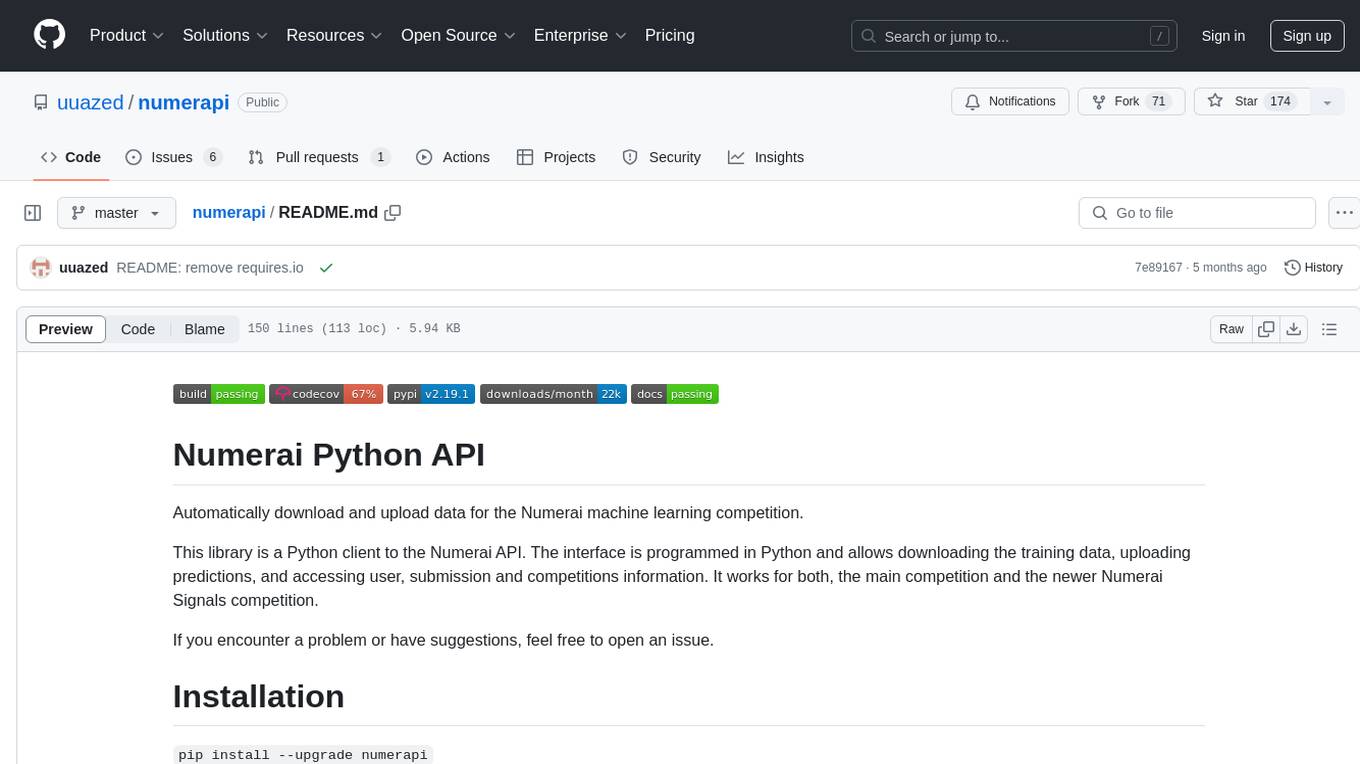
numerapi
Numerapi is a Python client to the Numerai API that allows users to automatically download and upload data for the Numerai machine learning competition. It provides functionalities for downloading training data, uploading predictions, and accessing user, submission, and competitions information for both the main competition and Numerai Signals competition. Users can interact with the API using Python modules or command line interface. Tokens are required for certain actions like uploading predictions or staking, which can be obtained from Numer.ai account settings. The tool also supports features like checking new rounds, getting leaderboards, and managing stakes.
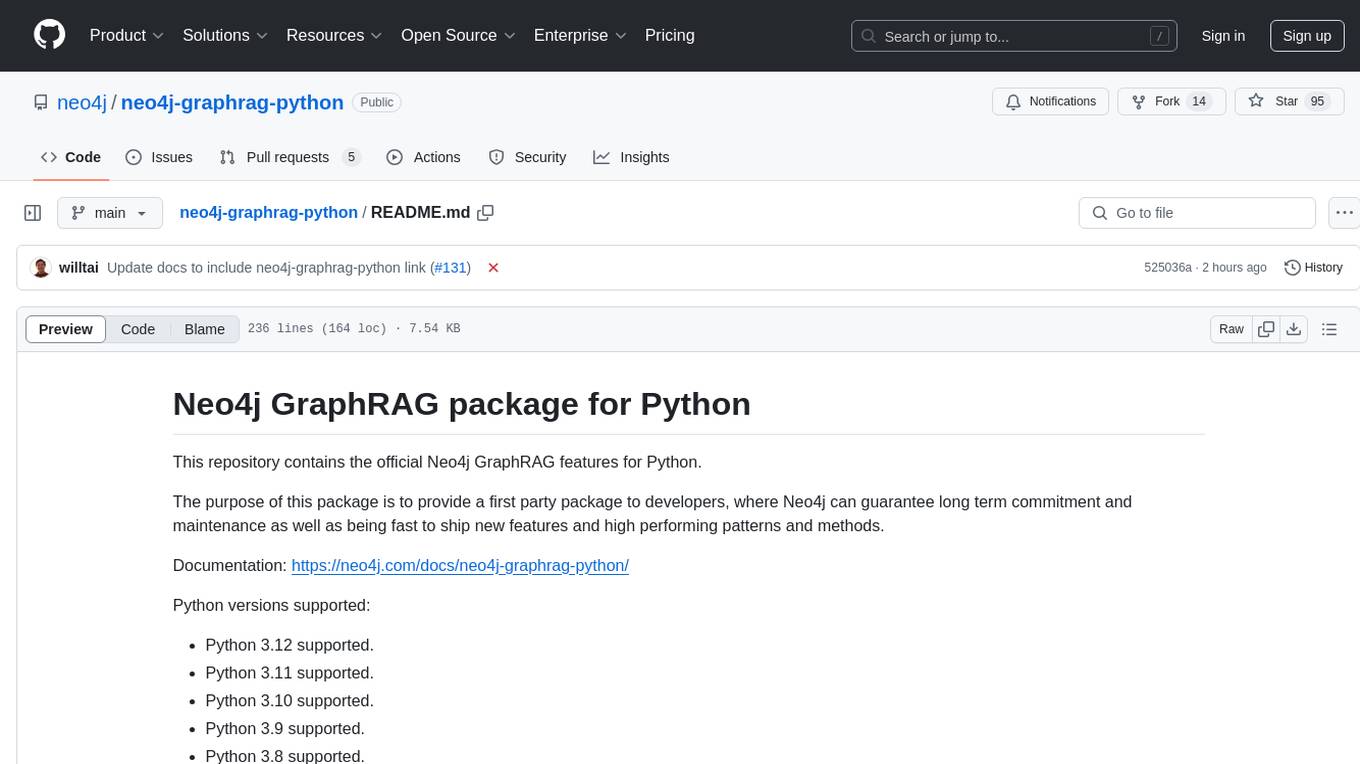
neo4j-graphrag-python
The Neo4j GraphRAG package for Python is an official repository that provides features for creating and managing vector indexes in Neo4j databases. It aims to offer developers a reliable package with long-term commitment, maintenance, and fast feature updates. The package supports various Python versions and includes functionalities for creating vector indexes, populating them, and performing similarity searches. It also provides guidelines for installation, examples, and development processes such as installing dependencies, making changes, and running tests.
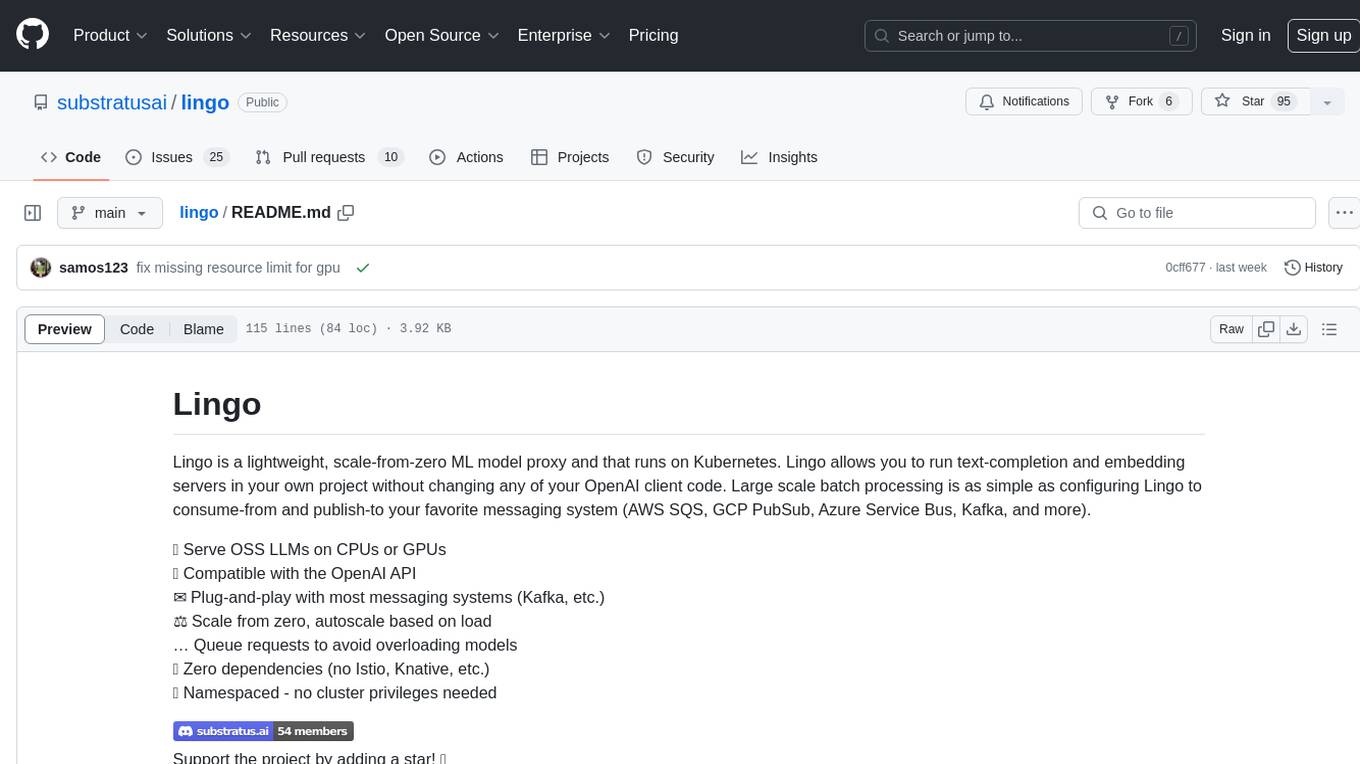
lingo
Lingo is a lightweight ML model proxy that runs on Kubernetes, allowing you to run text-completion and embedding servers without changing OpenAI client code. It supports serving OSS LLMs, is compatible with OpenAI API, plug-and-play with messaging systems, scales from zero based on load, and has zero dependencies. Namespaced with no cluster privileges needed.
talking-avatar-with-ai
The 'talking-avatar-with-ai' project is a digital human system that utilizes OpenAI's GPT-3 for generating responses, Whisper for audio transcription, Eleven Labs for voice generation, and Rhubarb Lip Sync for lip synchronization. The system allows users to interact with a digital avatar that responds with text, facial expressions, and animations, creating a realistic conversational experience. The project includes setup for environment variables, chat prompt templates, chat model configuration, and structured output parsing to enhance the interaction with the digital human.
For similar tasks

Azure-Analytics-and-AI-Engagement
The Azure-Analytics-and-AI-Engagement repository provides packaged Industry Scenario DREAM Demos with ARM templates (Containing a demo web application, Power BI reports, Synapse resources, AML Notebooks etc.) that can be deployed in a customer’s subscription using the CAPE tool within a matter of few hours. Partners can also deploy DREAM Demos in their own subscriptions using DPoC.
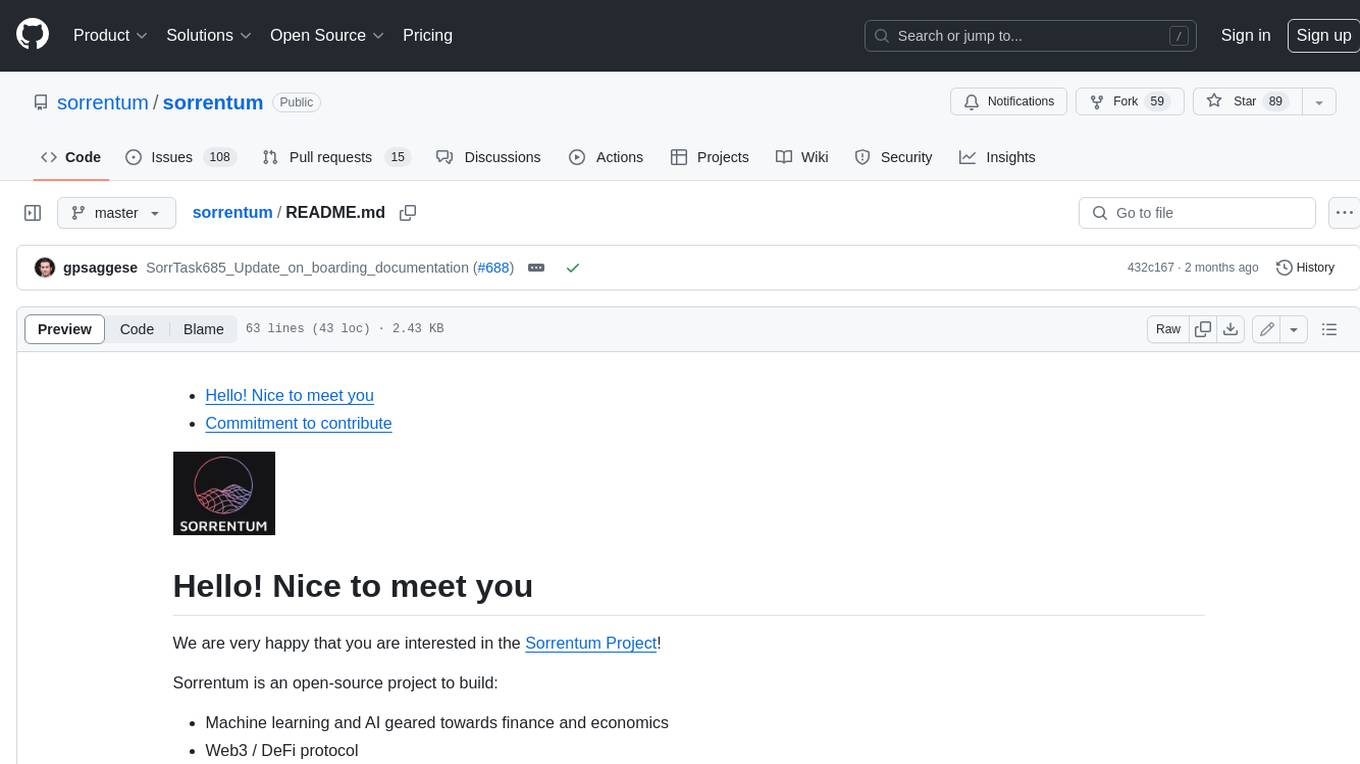
sorrentum
Sorrentum is an open-source project that aims to combine open-source development, startups, and brilliant students to build machine learning, AI, and Web3 / DeFi protocols geared towards finance and economics. The project provides opportunities for internships, research assistantships, and development grants, as well as the chance to work on cutting-edge problems, learn about startups, write academic papers, and get internships and full-time positions at companies working on Sorrentum applications.

tidb
TiDB is an open-source distributed SQL database that supports Hybrid Transactional and Analytical Processing (HTAP) workloads. It is MySQL compatible and features horizontal scalability, strong consistency, and high availability.

zep-python
Zep is an open-source platform for building and deploying large language model (LLM) applications. It provides a suite of tools and services that make it easy to integrate LLMs into your applications, including chat history memory, embedding, vector search, and data enrichment. Zep is designed to be scalable, reliable, and easy to use, making it a great choice for developers who want to build LLM-powered applications quickly and easily.
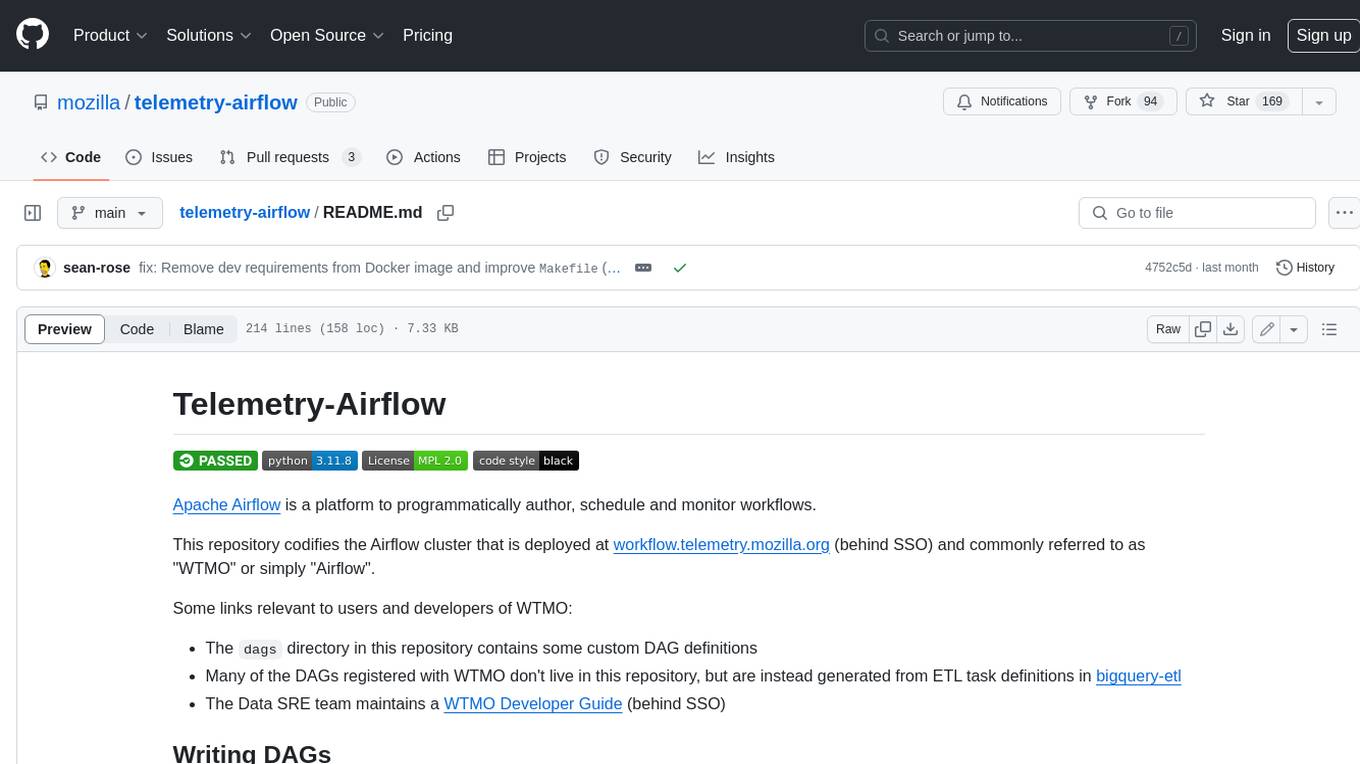
telemetry-airflow
This repository codifies the Airflow cluster that is deployed at workflow.telemetry.mozilla.org (behind SSO) and commonly referred to as "WTMO" or simply "Airflow". Some links relevant to users and developers of WTMO: * The `dags` directory in this repository contains some custom DAG definitions * Many of the DAGs registered with WTMO don't live in this repository, but are instead generated from ETL task definitions in bigquery-etl * The Data SRE team maintains a WTMO Developer Guide (behind SSO)
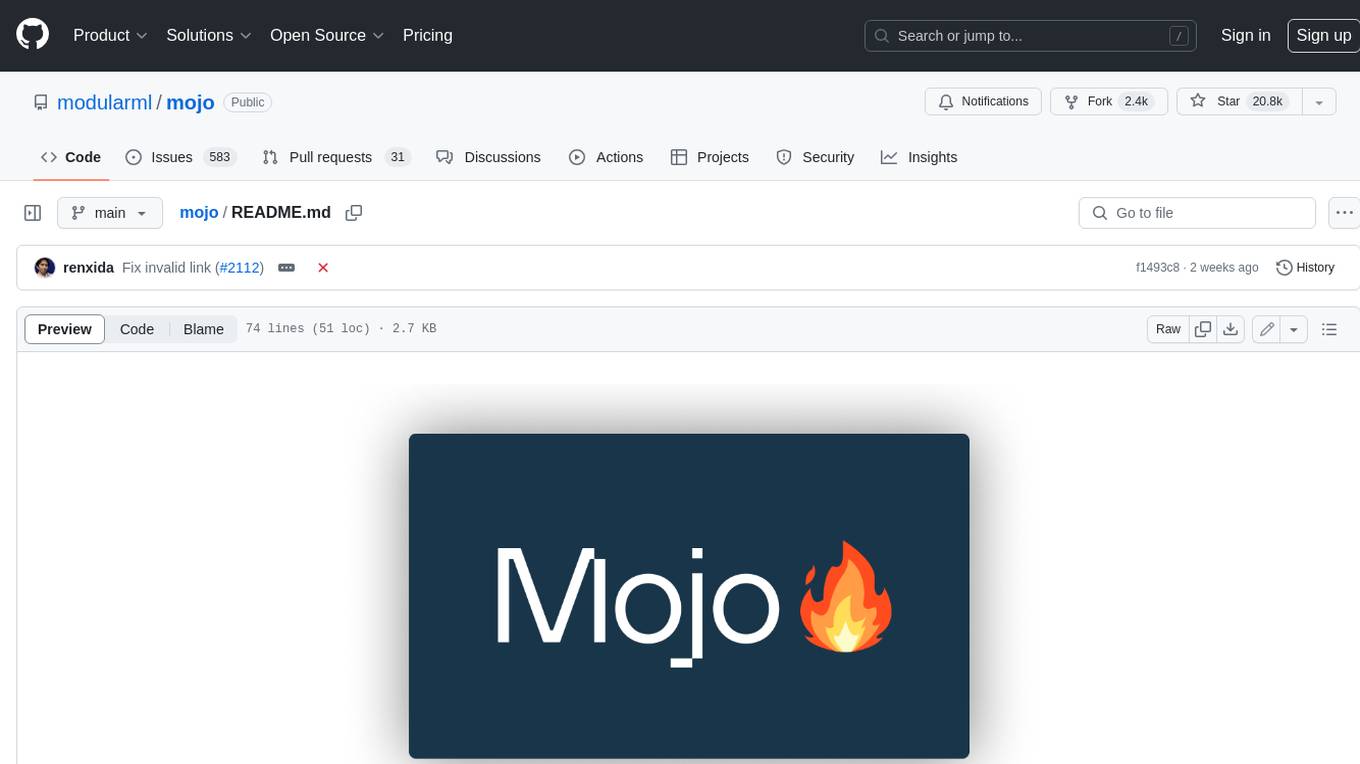
mojo
Mojo is a new programming language that bridges the gap between research and production by combining Python syntax and ecosystem with systems programming and metaprogramming features. Mojo is still young, but it is designed to become a superset of Python over time.
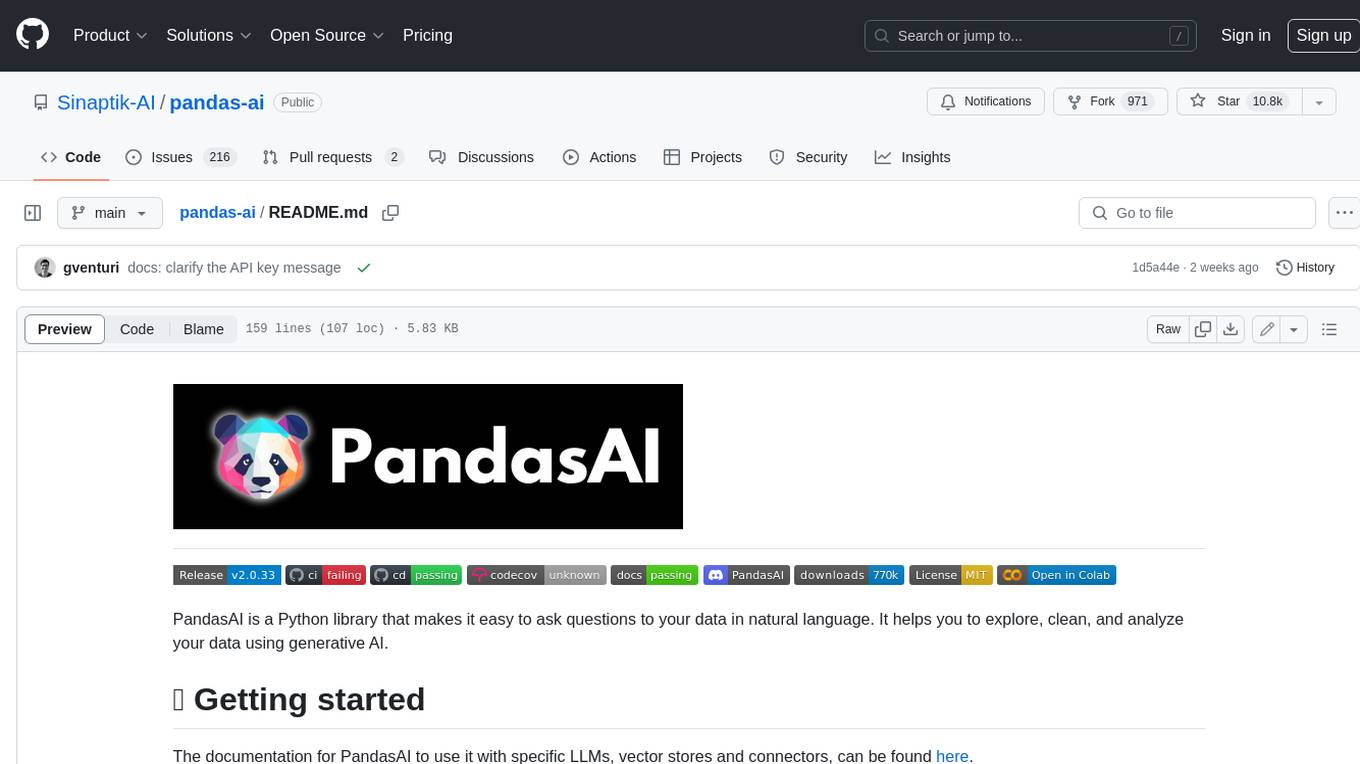
pandas-ai
PandasAI is a Python library that makes it easy to ask questions to your data in natural language. It helps you to explore, clean, and analyze your data using generative AI.
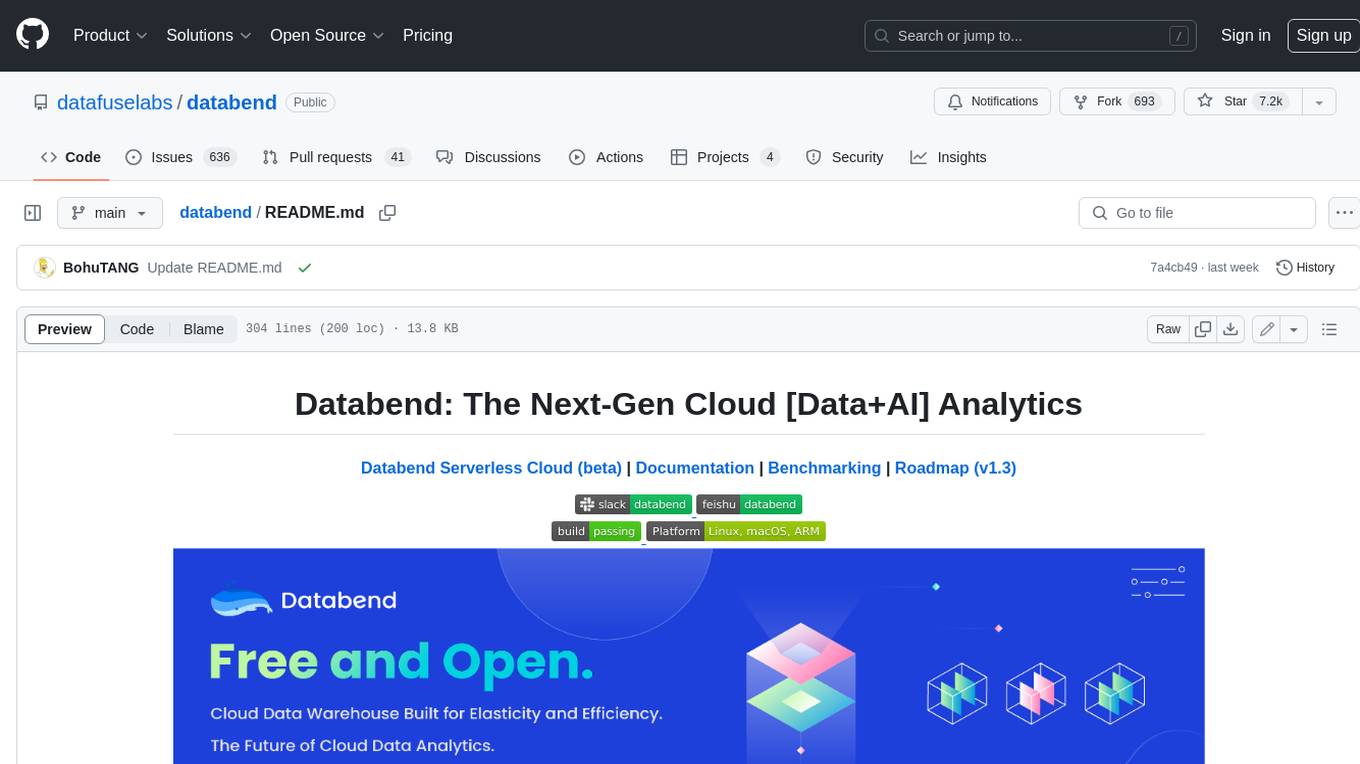
databend
Databend is an open-source cloud data warehouse that serves as a cost-effective alternative to Snowflake. With its focus on fast query execution and data ingestion, it's designed for complex analysis of the world's largest datasets.
For similar jobs

weave
Weave is a toolkit for developing Generative AI applications, built by Weights & Biases. With Weave, you can log and debug language model inputs, outputs, and traces; build rigorous, apples-to-apples evaluations for language model use cases; and organize all the information generated across the LLM workflow, from experimentation to evaluations to production. Weave aims to bring rigor, best-practices, and composability to the inherently experimental process of developing Generative AI software, without introducing cognitive overhead.

LLMStack
LLMStack is a no-code platform for building generative AI agents, workflows, and chatbots. It allows users to connect their own data, internal tools, and GPT-powered models without any coding experience. LLMStack can be deployed to the cloud or on-premise and can be accessed via HTTP API or triggered from Slack or Discord.

VisionCraft
The VisionCraft API is a free API for using over 100 different AI models. From images to sound.

kaito
Kaito is an operator that automates the AI/ML inference model deployment in a Kubernetes cluster. It manages large model files using container images, avoids tuning deployment parameters to fit GPU hardware by providing preset configurations, auto-provisions GPU nodes based on model requirements, and hosts large model images in the public Microsoft Container Registry (MCR) if the license allows. Using Kaito, the workflow of onboarding large AI inference models in Kubernetes is largely simplified.

PyRIT
PyRIT is an open access automation framework designed to empower security professionals and ML engineers to red team foundation models and their applications. It automates AI Red Teaming tasks to allow operators to focus on more complicated and time-consuming tasks and can also identify security harms such as misuse (e.g., malware generation, jailbreaking), and privacy harms (e.g., identity theft). The goal is to allow researchers to have a baseline of how well their model and entire inference pipeline is doing against different harm categories and to be able to compare that baseline to future iterations of their model. This allows them to have empirical data on how well their model is doing today, and detect any degradation of performance based on future improvements.

tabby
Tabby is a self-hosted AI coding assistant, offering an open-source and on-premises alternative to GitHub Copilot. It boasts several key features: * Self-contained, with no need for a DBMS or cloud service. * OpenAPI interface, easy to integrate with existing infrastructure (e.g Cloud IDE). * Supports consumer-grade GPUs.

spear
SPEAR (Simulator for Photorealistic Embodied AI Research) is a powerful tool for training embodied agents. It features 300 unique virtual indoor environments with 2,566 unique rooms and 17,234 unique objects that can be manipulated individually. Each environment is designed by a professional artist and features detailed geometry, photorealistic materials, and a unique floor plan and object layout. SPEAR is implemented as Unreal Engine assets and provides an OpenAI Gym interface for interacting with the environments via Python.

Magick
Magick is a groundbreaking visual AIDE (Artificial Intelligence Development Environment) for no-code data pipelines and multimodal agents. Magick can connect to other services and comes with nodes and templates well-suited for intelligent agents, chatbots, complex reasoning systems and realistic characters.

